Some of the most beautiful work of this craftsman, and many others, are in this book “Liège Gunmakers through their Work. 1800 - 1950”.
For more detail see: LIEGE GUNMAKERS
GALAND "De Guerre"
This is a
beautiful revolver in very good condition with its deep, barely altered bronze
finish. It features the best technical advances available in the second half of
the 19th century:
Short octagonal
barrel
6-shot cylinder
with breech blocks
Probably 12mm
Galand caliber
Rebounding
hammer
Single and
double action
Captive grip
Disassembles
without tools
The weapon's
markings clearly indicate that it is a production of the French gunsmith and
inventor Charles-François Galand, well known on the LittleGun website. Highly
creative and always on the lookout for international innovations,
Charles-François Galand (1832-1900) worked in Paris (France), Liège (Belgium),
and Birmingham (England), where he maintained close industrial and commercial
relationships with British gunsmiths. The revolver examined here is an example
of the so-called "Galand de Guerre" model, the genesis and description of which
are reported on the LittleGun website and reproduced below:
Text by GP: "Let's return to France, where Galand participated, after the war of
1870-71, in the trials leading to the adoption of a new handgun, in this case a
revolver. Galand initially considered an improved version of his Model 1868, but
since the Vincennes Permanent Shooting Commission wanted a "homogeneous" weapon
(i.e., with a closed frame), there was no longer any question of proposing an
open-frame weapon. From then on, Galand created in 1872 (patents dated February
28, June 24, and September 24 of that year) a weapon of great simplicity and
elegance, but more expensive than the Chamelot-Delvigne, which would ultimately
win. The Commission also criticized the Galand for its overly small loading door
and the pushbuttons releasing the ejector rod. There are two (extremely rare)
models of this revolver, one chambered for the large-rim Galand ammunition, the
other for the 11 mm Chamelot-Delvigne. The civilian version of this so-called
War revolver was not very successful, although it was presented with very
careful finishing and with a special clip for reloading the 18 steel cases.
Equally rare is the second type of this revolver, with the main differences
being a bouncing lock and a screw to make the left plate captive. This second
type even existed with two cylinders, one for the 11 mm Galand, the other for
the 11 mm Chamelot-Delvigne. After these failures on the military front, Galand
turned its attention to the civilian market.
This text is
taken from this page, which also includes original plates.
Markings:
Left side of
barrel: Z under star, inspection mark in effect from January 27, 1877.
Left side of
receiver: Galand Fabt, for Galand Fabricant.
Number 698
(serial number?)
Rear cylinder: Z
under star, proof mark in effect from January 27, 1877.
ELG oval over
star, proof mark in effect from 1846 to 1893.
Front cylinder:
Initials C.F.G.,
for Charles François Galand
Number 3
This is indeed a Galand de Guerre revolver, manufactured in Liège by Charles-François Galand between 1877 and 1893, most likely at the very beginning of this period.
Chris, HPH, GP
Note:
A PDF version of
a book by Charles-François Galand entitled: "The War Revolver in 1873, with
Appendix: Technical Manual for the Use of the Galand Revolver, with a Door and a
Ram, and the Mechanism of Which Can Be Disassembled Without Tools" is available,
in which the author discusses his revolver and its contemporary competitors.
This book can be downloaded from the following link:
https://gallica.bnf.fr/ark:/12148/bpt6k940000s#
The book has
been reissued in paperback by Hachette-BNF and is easily available for a small
fee from online bookstores.
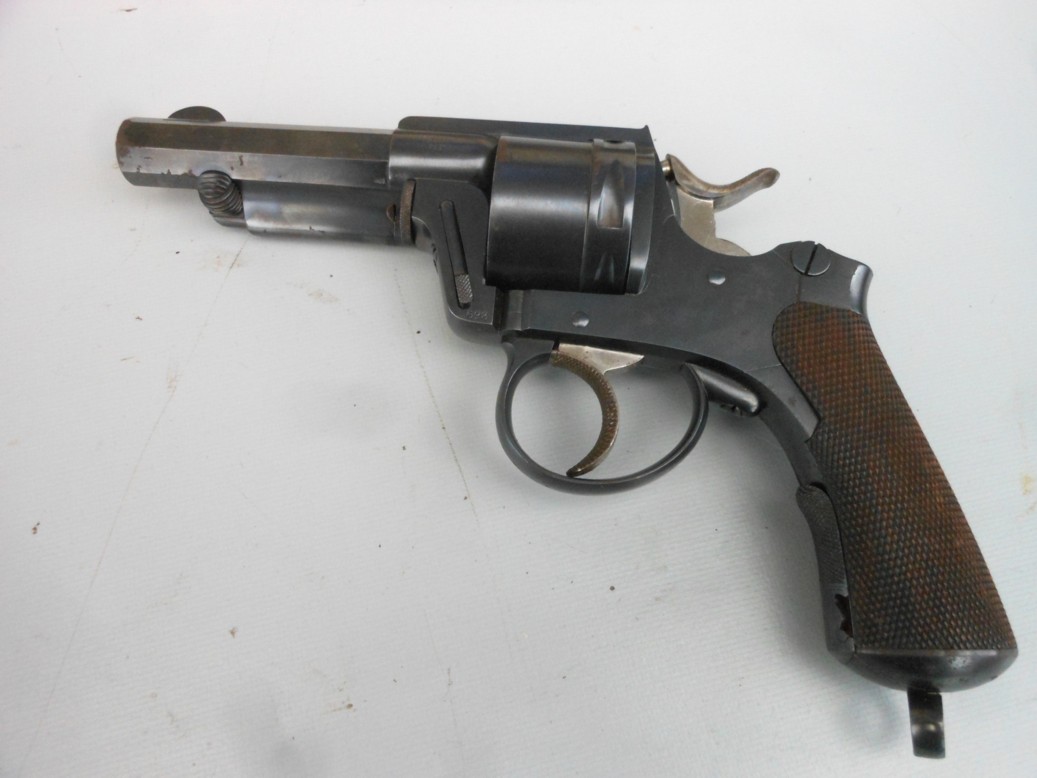
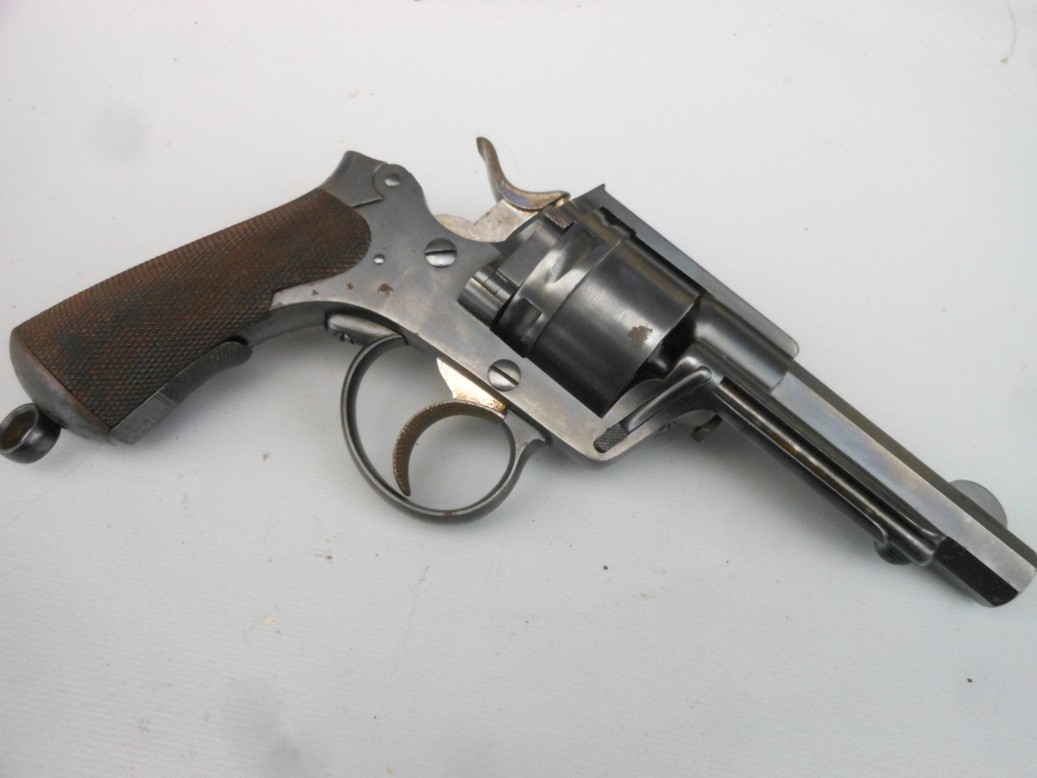
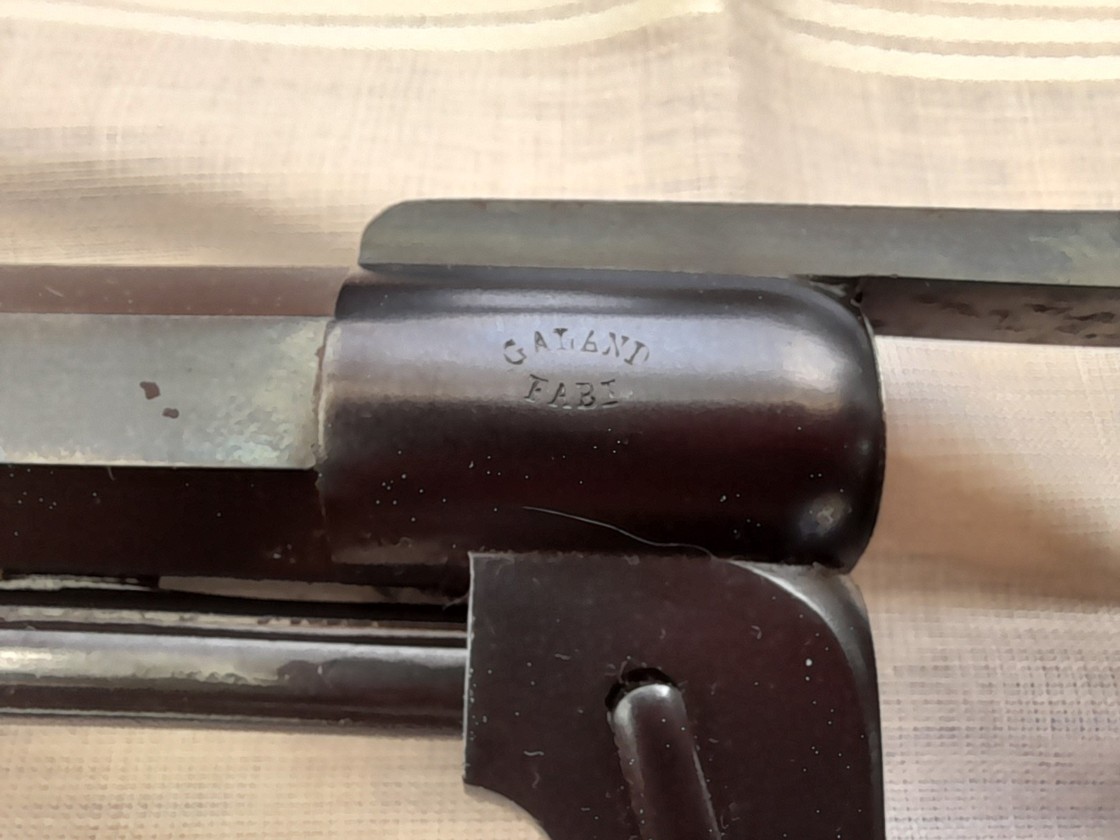
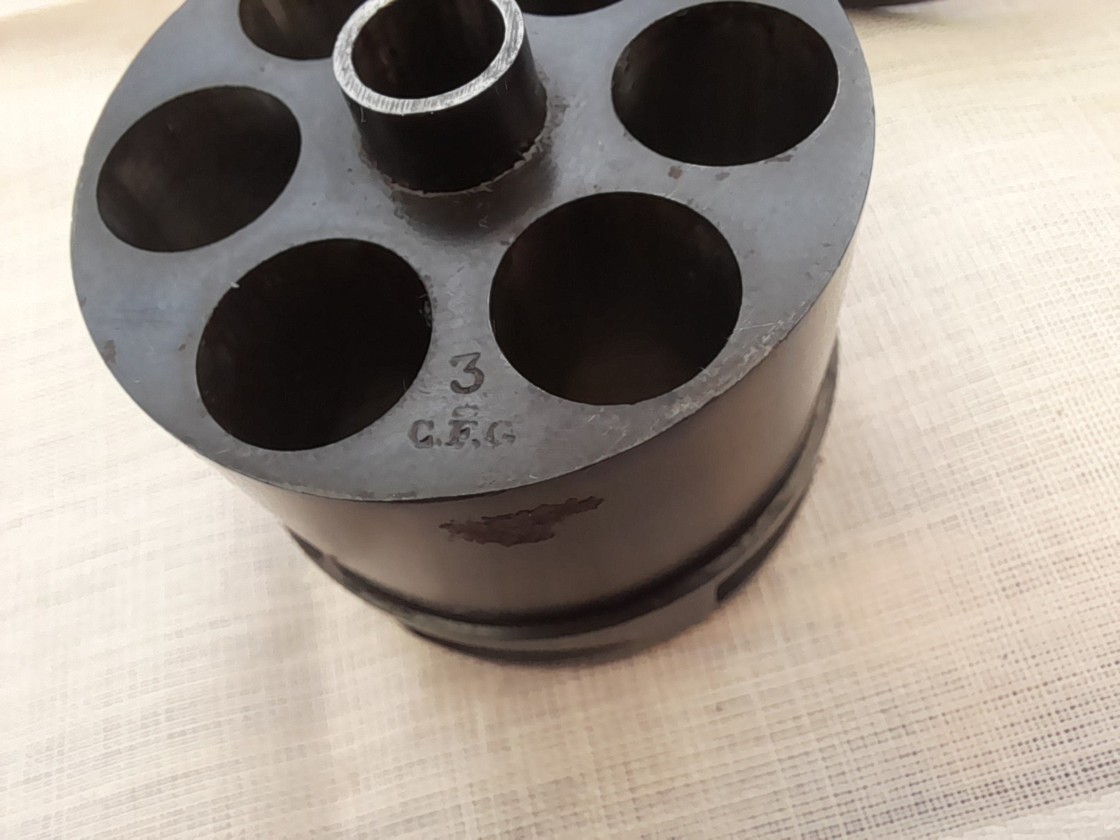
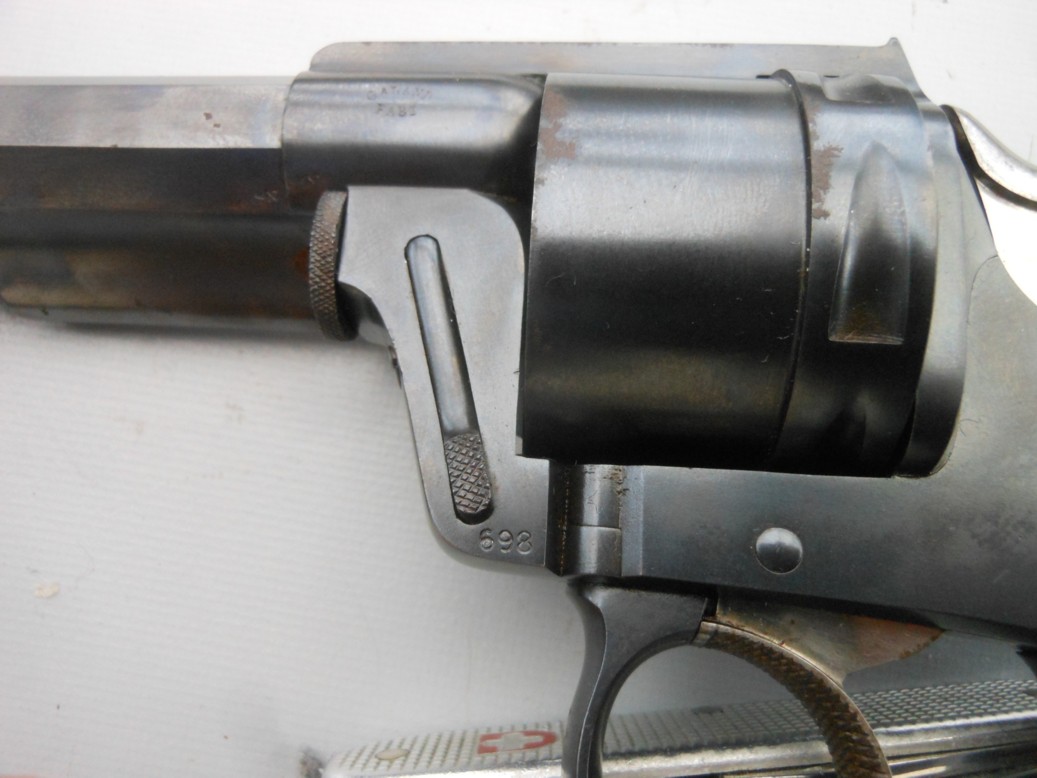
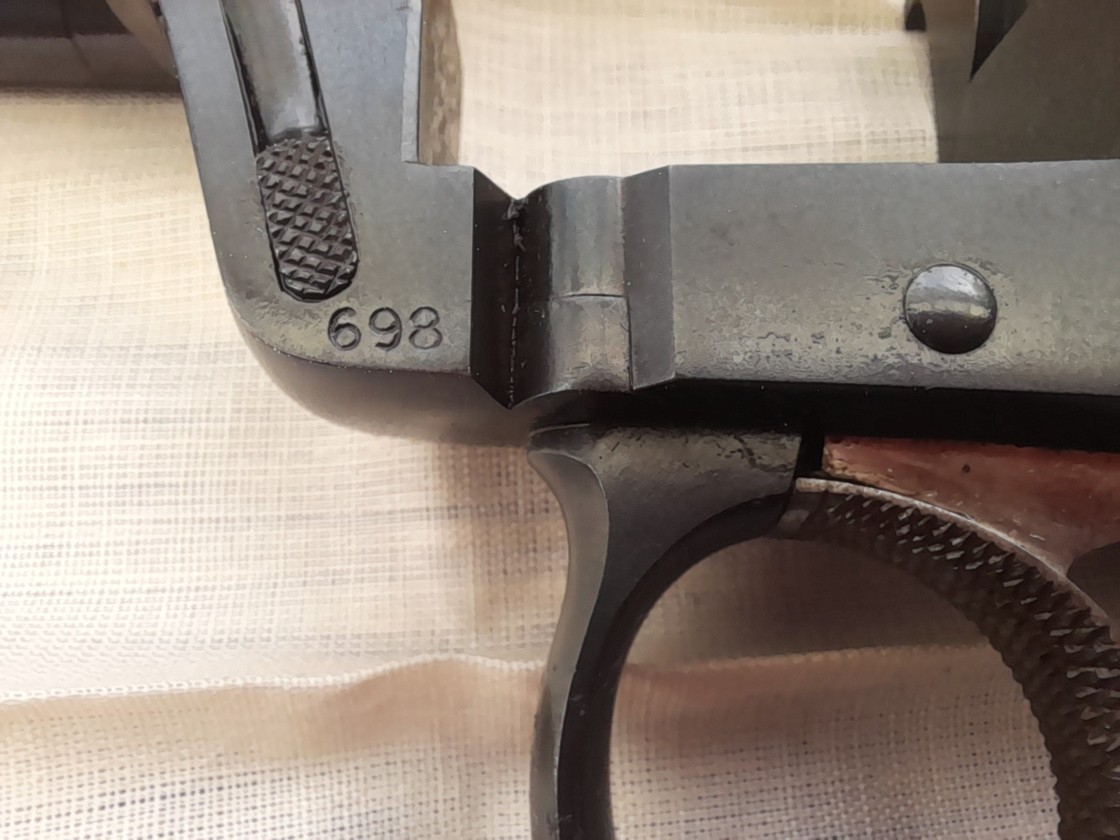
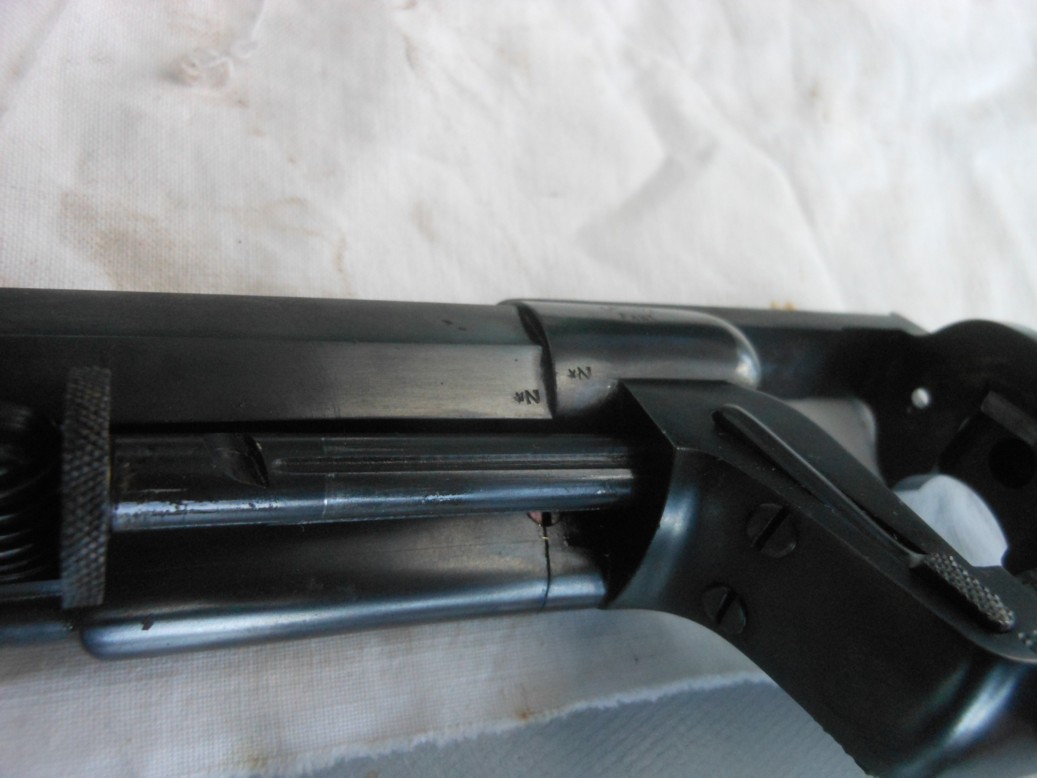
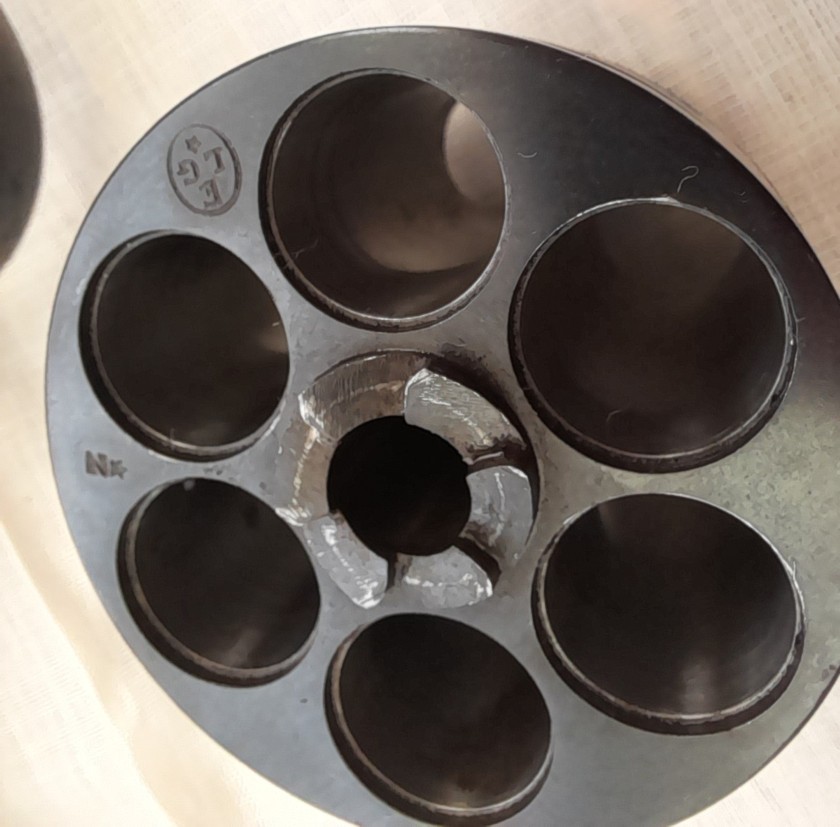
Galand "De Guerre"
Here is another quite rare revolver, there is mention of it on your site, but I have never before seen a picture of one of these even less held one in my hand. I believe this is the one referred in the Galand section of your site (third paragraph) as the "second type" with the ability to open the left side-plate.
What was interesting is that when I first purchased the revolver and had no idea what it was I tried to open the loading gate on the right side and had the same experience as the French Commission that rejected the revolver, it was too small and too difficult to get my fingers around for opening (which I finally did with some difficulty). Also this revolver was originally engraved, the engraving now quite diminished by the overall surface pitting.
My questions:
Is this considered a Galand 1872 Ordinance Revolver (Galand de Guerre), Second Type? or is there another designation for this particular revolver?
There is a mark on the lower part of the recoil shield on the left side that is somewhat clear, but I cannot make it out (photo L).
Would the marks of J or AD on the frame have any significance or would they just be shop marks?
Approximately what year would this have been manufactured?
Would the crown over N on the right of the barrel be a Belgian mark? In that case, did Galand have this revolver manufactured in Belgium? I could find no Liege proof.
Here is my information:
French Galand Model 1872 Ordinance Revolver (Galand de Guerre) Second Type?
Caliber: 12mm Galand thick rim
Serial Nº: 110 (the number 26 is stamped on several parts, evidently an assembly number)
Dimensions: barrel 5-11/16 inches (144mm), overall length 10-5/8 inches (270mm)
Mechanical details: this does use the Galand lock, similar to the Austrian Model 1898 Revolver, but there are three! springs in the mechanism. This revolver has the ingenious system of a turning lever on the lower front of the grip that locks into two positions; one for keeping the revolver closed, the other for removing first the grip assembly then the left side plate. On the left of the frame is a spring-loaded push lever that allows the center post to be removed. The extraction assembly looks like the Chamelot-Delvigne system to me, but perhaps it is also a Galand invention.
Marks:
on the left of the action: 110
on several parts: 26
on the left side of the recoil plate: a deep stamp with perhaps an L or G?
on the right of the barrel: crown/N (looks like the Belgian 1853-1877 inspection mark)
on the left of the frame under the grip: J
on the right of the frame under the grip: AD
Richard
The weapon
You describe perfectly your weapon which is a revolver of war GALAND, models long, in civil version, I will thus not return there.
Punches
Only the punch N crowned (of use of 1853 to 1877) appears on this weapon, it acts of the countermark of a controller of the proofhouse of LIEGE what indicates with certainty the origin of the weapon. The second lawful punch of Liège was an oval containing letters ELG on star (1846/1893). It probably disappeared under rust.
Date of manufacture:
This punch indicates a manufacture between 1872 (date of the patent) and 1877 (expiry of the punch)
The manufacturer:
According to TAYLERSON, Charles François GALAND was an arms manufacturer of Liège. We think it French for our part. It is deceased in 1900 and was replaced with the businesses by his son Rene GALAND. To how will see it you on the heading of letter attached, it had activities in PARIS, LIEGE and BIRMINGHAM! It had a workshop street Vivegnis n° 242 and 288 then rue de la Loi n° 7 in Liege.
The figure: 26 on several parts is most probably a serial number.
I don’t have any assumption for figure 110.
With regard to initial AD and J, they are with my direction marks subcontractors. They were very numerous in Liege and were unfortunately never indexed.
Appendices
a) Heading of a letter GALAND
b) Cover of a catalogue Rene GALAND in LIEGE.
c) technical drawing of the revolver of war.
d) drawing of the grip invented by Galand.
GG


















